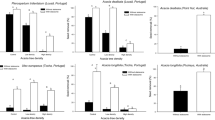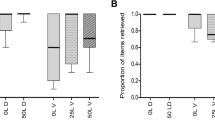Abstract
Ants collect and disperse seeds that bear an attractive nutritive body called the elaiosome. In mesic habitats, many myrmecochorous plant species have elaiosomes that are usually soft and desiccation-sensitive. The aim of this study was to link the desiccation rate of two species of seeds (Chelidonium majus and Viola odorata) to the seed-removing behaviour of the ant Myrmica rubra. In laboratory experiments seeds of both species lost one-third of their weight in 24 h. Concurrently, seed removal rates decreased sharply (92%) for Viola odorata over 24 h and slowly for Chelidonium majus, which retained one-third of its attractiveness after one month of desiccation. Seeds recovered their initial weight almost entirely after being soaked in water for 18 h. This rehydration partially (Viola odorata) or totally (Chelidonium majus) restored the attractiveness of the seeds. In this paper, we show that the window of seed attractiveness during which ant–plant interactions occur is desiccation-dependent and plant-specific.




Similar content being viewed by others
References
Bascompte J, Jordano P (2007) Plant-animal mutualistic networks: the architecture of biodiversity. Ann Rev Ecol Syst 38:567–593
Beattie A, Hughes L (2002) Ant–plant interactions. In: Herrera CM, Pellmyr O (eds) Plant–animal interactions: an evolutionary approach. Blackwell, Oxford, pp 211–235
Berg RY (1958) Seed dispersal, morphology, and phylogeny of Trillium. Skr Norske Vidensk-Akad Mat-Naturvidensk 1:1–36
Berg RY (1966) Seed dispersal of Dendromecon: its ecologic, evolutionary, and taxonomic significance. Am J Bot 53:61–73
Berg RY (1975) Myrmecochorous plants in Australia and their dispersal by ants. Aust J Bot 23:475–508
Bianchini M, Pacini E (1996) The caruncle of Ricinus communis L. (Castor Bean): its development and role in seed dehydration, rehydration, and germination. Int J Plant Sci 157:40–48
Boulay R, Carro F, Soriguer RC, Cerda X (2007) Synchrony between fruit maturation and effective dispersers’ foraging activity increases seed protection against seed predators. Proc R Soc Lond B 274:2515–2522
Bresinsky A (1963) Bau, Entwicklungsgeschichte und Inhaltsstoffe der Elaiosomen Studien zur myrmekochoren Verbreitung von Samen und Früchhten. Bibl Bot 126:1–54
Brew CR, O’Dowd DJ, Rae ID (1989) Seed dispersal by ants: behaviour-releasing compounds in elaiosomes. Oecologia 80:490–497
Bülow-Olsen A (1984) Diplochory in Viola: a possible relation between seed dispersal and soil seed bank. Am Midl Nat 112:251–260
Cammaerts M-C (1977) Recrutement d’ouvrières vers une source d’eau pure ou sucrée chez la fourmi Myrmica rubra L. Biol Behav 2:287–308
Cardina J, Norquay HM, Stinner BR, McCartney DA (1996) Postdispersal predation of velvetleaf (Abutilon theophrasti) seeds. Weed Sci 44:534–539
Carroll CR, Janzen DH (1973) Ecology of foraging by ants. Annu Rev Ecol Syst 4:231–257
Delatte E, Chabrerie O (2008) Performances des plantes herbacées dorestières dans la dispersion de leurs graines par la fourmi Myrmica ruginodis. C R Biol 331:309–320
Edwards W, Dunlop M, Rodgerson L (2006) The evolution of rewards: seed dispersal, seed size and elaiosome size. J Ecol 94:687–694
Elzinga JA, Atlan A, Biere A, Gigord L, Weis A, Bernasconi G (2007) Time after time: flowering phenology and biotic interactions. Trends Ecol Evol 22:432–439
Fedriani JM, Rey PJ, Garrido JL, Guitián J, Herrera CM, Medrano M, Sánchez-Lafuente AM, Cerdá X (2004) Geographical variation in the potential of mice to constrain an ant-seed dispersal mutualism. Oikos 105:181–191
Gorb SN, Gorb EV (1995) Removal rates of seeds of five myrmecochorous plants by the ant Formica polyctena (Hymenoptera: Formicidae). Oikos 73:367–374
Gorb SN, Gorb EV (1999) Effects of ant species composition on seed removal in deciduous forest in eastern Europe. Oikos 84:110–118
Guitián P, Medrano M, Guitián J (2003) Seed dispersal in Erythronium dens-canis L (Liliaceae): variation among habitats in a myrmecochorous plant. Plant Ecol 169:171–177
Hanzawa FM, Beattie A, Holmes A (1985) Dual function of the elaiosome of Corydalis aurea (Fumariaceae): attraction of dispersal agents and repulsion of Peromyscus maniculatus, a seed predator. Am J Bot 72:1707–1711
Heithaus ER (1981) Seed predation by rodents on three ant-dispersed plants. Ecology 62:136–145
Heithaus ER, Heithaus PA, Liu SY (2005) Satiation in collection of myrmecochorous diaspores by colonies of Aphaenogaster rudis (Formicidae: Myrmicinae) in central Ohio, USA. J Insect Behav 18:827–846
Herrera CM (2002) Seed dispersal by vertebrates. In: Herrera CM, Pellmyr O (eds) Plant–animal interactions: an evolutionary approach. Blackwell, Oxford, pp 185–208
Hughes L, Westoby M, Jurado E (1994) Convergence of elaisomes and insect prey: evidence from ant foraging behavior and fatty acid composition. Funct Ecol 8:358–365
Janet C (1897) Études sur les fourmis, les guêpes et les abeilles. Note 15: Appareils pour l’observation des fourmis et des animaux myrmécophiles. Mémoires de la Société Zoologique de France 10:302–323
Kjellsson G (1985) Seed fate in a population of Carex pilulifera L. I. Seed dispersal and ant-seed mutualism. Oecologia 67:416–423
Lambinon J, de Langhe J-E, Delvosalle L, Duvigneaud J (1992) Nouvelle flore de la Belgique, du Grand-Duché de Luxembourg, du nord de la France et des régions voisines (Ptéridophytes et Spermatophytes). Jardin Botanique de Belgique, Meise
Le Roux AM, Le Roux G, Thibout E (2002) Food experience on the predatory behavior of the ant Myrmica rubra towards a specialist moth, Acrolepiopsis assectella. J Chem Ecol 28:2307–2314
Lundgren JG (2009) Relationships of natural enemies and non-prey foods. Springer, Dordrecht
Manzaneda AJ, Fedriani JM, Rey PJ (2005) Adaptive advantages of myrmecochory: the predator-avoidance hypothesis tested over a wide geographic range. Ecography 28:583–592
Manzaneda AJ, Rey PJ, Boulay R (2007) Geographic and temporal variation in the ant-seed dispersal assemblage of the perennial herb Helleborus foetidus L. (Ranunculaceae). Biol J Linn Soc 92:135–150
Mark S, Olesen JM (1996) Importance of elaiosome size to removal of ant-dispersed seeds. Oecologia 107:95–101
Mayer V, Ölzant S, Fischer RC (2005) Myrmecochorous seed dispersal in temperate regions. In: Forget P-M, Lambert JE, Hulme PE, Vander Wall SB (eds) Seed fate: predation, dispersal and seedling establishment. CABI Publishing, Wallingford, pp 175–195
Oberrath R, Bohning-Gaese K (2002) Phenological adaptation of ant-dispersed plants to seasonal variation in ant activity. Ecology 83:1412–1420
Ohara M, Higashi S (1987) Interference by ground beetles with the dispersal by ants of seeds of Trillium species (Liliaceae). J Ecol 75:1091–1098
Pausch RD, Pausch LM (1980) Observations on the biology of the slender seedcorn beetle, Clivina impressifrons (Coleoptera: Carabidae). Great Lakes Entomol 13:189–194
Pellmyr O (2002) Pollination by animals. In: Herrera CM, Pellmyr O (eds) Plant–animal interactions: an evolutionary approach. Blackwell, Oxford, pp 157–184
Peters M, Oberrath R, Böhning-Gaese K (2003) Seed dispersal by ants: are seed preferences influenced by foraging strategies or historical constraints? Flora 198:413–420
Ready CC, Vinson SB (1995) Seed selection by the red imported fire ant (Hymenoptera: Formicidae) in the laboratory. Environ Entomol 24:1422–1431
Sernander R (1906) Entwurf einer Monographie der europäischen Myrmekochoren. K Sv Vetensk Akad Handl 41:1–410
Servigne P, Detrain C (2008) Ant–seed interactions: combined effects of ant and plant species on seed removal patterns. Insectes Sociaux 55:220–230
Smith BH, Rosenheim ML, Swartz KR (1986) Reproductive ecology of Jeffersonia diphylla (Berberidaceae). Am J Bot 73:1416–1426
Szemes G (1943) Zur Entwicklung des Elaiosoms von Chelidonium majus. Öst Bot Zeit 92:215–219
Turnbull CL, Culver DC (1983) The timing of seed dispersal in Viola nuttallii: attraction of dispersers and avoidance of predators. Oecologia 59:360–365
Wehner R (1987) Spatial organization of foraging behavior in individually searching desert ants, Cataglyphis (Sahara desert) and Ocymyrmex (Namib desert). In: Pasteels JM, Deneubourg J-L (eds) From individual to collective behavior in social insects. Birkhäuser, Basel, pp 15–42
Werker E, Fahn A (1975) Seed anatomy of Pancratium species from three different habitats. Bot Gaz 136:396–403
Zar JH (1999) Biostatistical analysis. Prentice Hall, Upper Saddle River
Acknowledgements
We are grateful to Raphael Boulay, Rob Dunn, Audrey Dussutour and anonymous referees for helpful comments on an earlier version of this manuscript, Lise Diez for help in statistical analyses, and Dominique Dewulf for help in collecting ant colonies. This study was funded by a FRIA (Fonds pour la formation à la recherche dans l’Industrie et dans l’Agriculture) Ph.D. grant attributed to Pablo Servigne. Claire Detrain is a senior research associate from the FNRS (Belgian National Fund for Scientific Research).
Author information
Authors and Affiliations
Corresponding author
Additional information
Handling editor: Heikki Hokkanen.
Rights and permissions
About this article
Cite this article
Servigne, P., Detrain, C. Seed desiccation limits removal by ants. Arthropod-Plant Interactions 3, 225–232 (2009). https://doi.org/10.1007/s11829-009-9076-5
Received:
Accepted:
Published:
Issue Date:
DOI: https://doi.org/10.1007/s11829-009-9076-5




